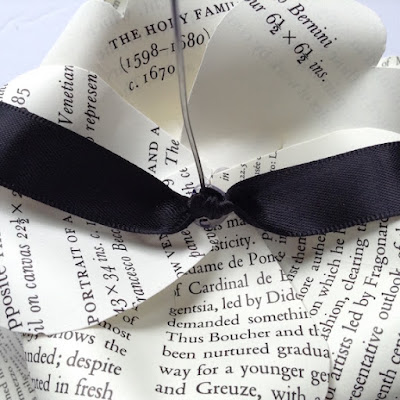Although peonies are not a spring flower, they are one of my favourites with their abundant show of petals and lemony sweet scent. With Easter coming soon, I made these paper peonies using paper stock from an old art book. The books I use for crafts are damaged library discards or old vintage books a step away from the recycling bin, but any recycled paper will do.
This easy tutorial is only a guideline, your own personal choices for sizes and shapes of petals are strongly encouraged.
You will need: Paper stock, Wire, Ribbon, Glue Gun, Scissors
*Cut a band of paper and fringe it to form the stamens.
Shape a little loop at one end of the wire, put a drop of glue on it and wrap the band of stamens around the end of the wire. Add a drop of glue every so often as you go along.
Using one blade of your scissors, curl the tip of each petals.
Cut the petal down the centre approximately half way, put a drop of glue and over lap the two corners to form a dart.
This will create a gentle curve and give your flower a natural appearance.Repeat this process to all your petals.
Starting with the smallest petals (#1), glue each one around the stamen making sure
to slightly overlap them.
Repeat the same process with petals #2 to #5.
This is what the underside of your flower should look like.
Optional - Add petals #6, glued so they curve in the opposite direction.
This is what it should look like. If you use these flowers for a wreath, I would skip the last step as these petals would serve no aesthetic purposes and would only be a nuisance.
Finish it off by tying a knot around the wire using a piece of ribbon and glue it in place.
Voila! This flower ended up measuring 7" across.
For this flower, I used images of portrait paintings.
This one has images of the virgin Mary.
In this example, I used a combination of both images and text,
and for this flower, I selected images depicting 18th century notables.
With pointy and narrow petals all curled inwards, this flower resembled a chrysanthemum.
Wishing you a lovely Easter celebration and a flowery springtime.























